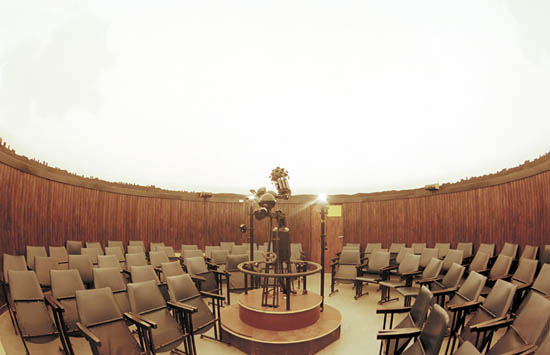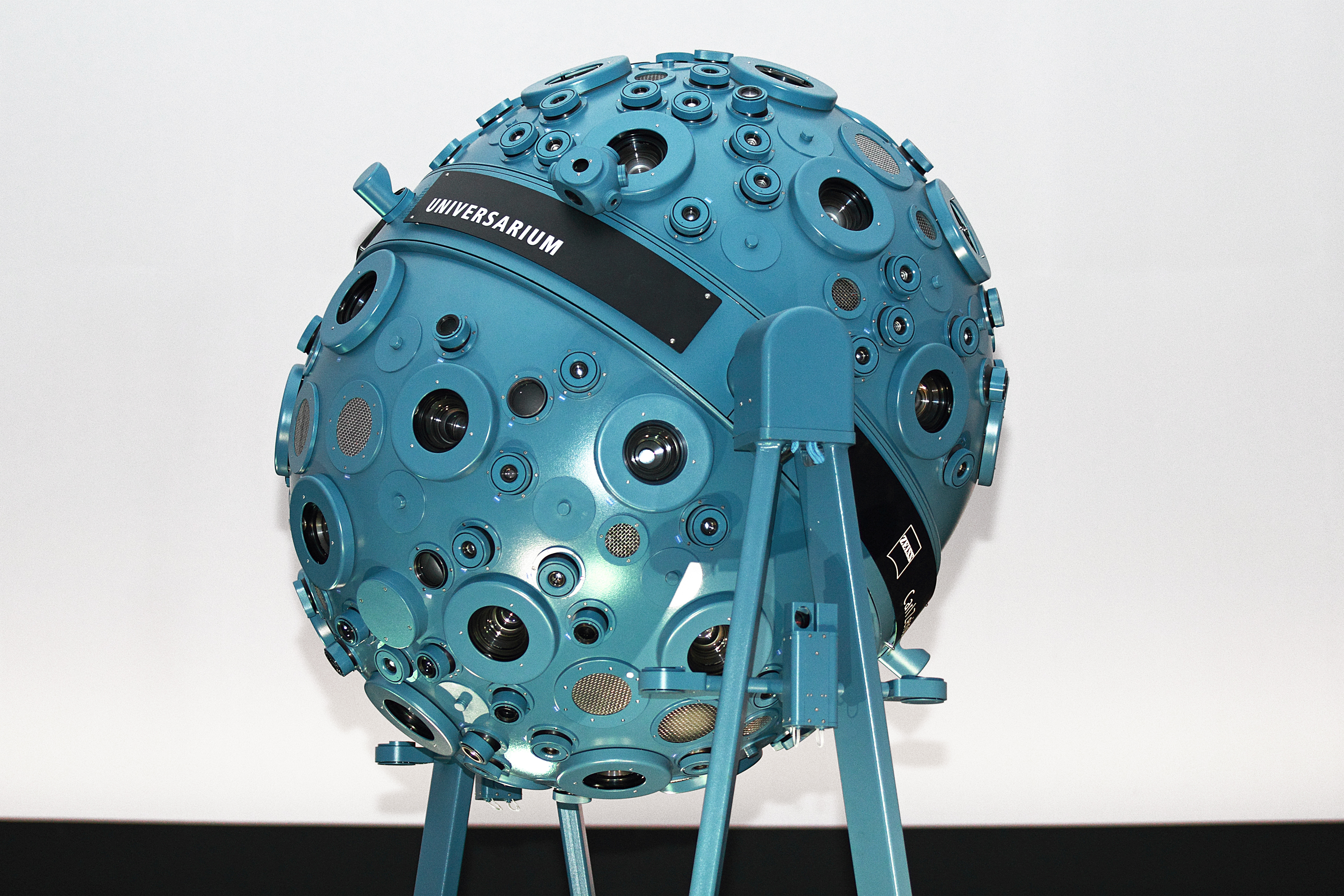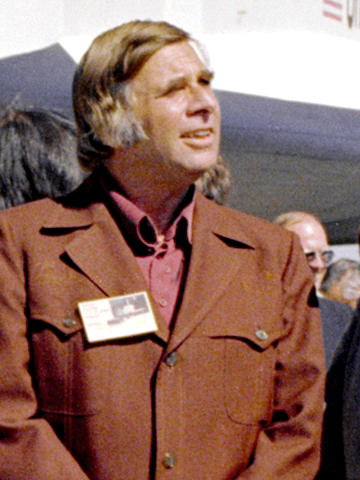|
Digistar
Digistar is the first computer graphics-based planetarium projection and content system. It was designed by Evans & Sutherland and released in 1983. The technology originally focused on accurate and high quality display of stars, including for the first time showing stars from points of view other than Earth's surface, travelling through the stars, and accurately showing celestial bodies from different times in the past and future. Beginning with the Digistar 3 the system now projects full-dome video. Projector Unlike modern full-dome systems, which use LCD, DLP, SXRD, or laser projection technology, the Digistar projection system was designed for projecting bright pinpoints of light representing stars. This was accomplished using a calligraphic display, a form of vector graphics, rather than raster graphics. The heart of the Digistar projector is a large cathode-ray tube (CRT). A phosphor plate is mounted atop the tube, and light is then dispersed by a large lens with a 160 deg ... [...More Info...] [...Related Items...] OR: [Wikipedia] [Google] [Baidu] |
Evans & Sutherland
Evans & Sutherland is an American computer graphics firm founded in 1968 by David C. Evans (computer scientist), David Evans and Ivan Sutherland. Its current products are used in digital projection environments like planetariums. Its simulation business, which it sold to Rockwell Collins, sold products that were used primarily by the United States Armed Forces, military and large industrial firms for training and simulation. History The company was founded in 1968 by David C. Evans (computer scientist), David C. Evans and Ivan Sutherland, professors in the Computer Science Department at the University of Utah. who were pioneers in computer graphics technology. They formed the company to produce hardware to run the systems being developed in the university, working from an abandoned barracks on the university grounds. The company was later housed in the University of Utah Research Park. Most of the employees were active or former students, and included James H. Clark, Jim Clark, ... [...More Info...] [...Related Items...] OR: [Wikipedia] [Google] [Baidu] |
Fulldome
Fulldome refers to immersive dome-based video display environments. The dome, horizontal or tilted, is filled with real-time (interactive) or pre-rendered (linear) computer animations, live capture images, or composited environments. Although the current technology emerged in the early-to-mid 1990s, fulldome environments have evolved from numerous influences, including immersive art and storytelling, with technological roots in domed architecture, planetariums, multi-projector film environments, flight simulation, and virtual reality. Initial approaches to moving fulldome imagery used wide-angle lenses, both 35mm and 70 mm film, but the expense and ungainly nature of the film medium prevented much progress; furthermore, film formats such as Omnimax did not cover the full two pi steradians of the dome surface, leaving a section of the dome blank (though, due to seating arrangements, that part of the dome was not seen by most viewers). Later approaches to fulldome utilized mo ... [...More Info...] [...Related Items...] OR: [Wikipedia] [Google] [Baidu] |
Planetarium
A planetarium (: planetariums or planetaria) is a theatre built primarily for presenting educational and entertaining shows about astronomy and the night sky, or for training in celestial navigation. A dominant feature of most planetariums is the large dome-shaped projection screen onto which scenes of stars, planets, and other celestial objects can be made to appear and move realistically to simulate their motion. The projection can be created in various ways, such as a star ball, slide projector, video, fulldome projector systems, and lasers. Typical systems can be set to simulate the sky at any point in time, past or present, and often to depict the night sky as it would appear from any point of latitude on Earth. Planetaria range in size from the 37 meter dome in St. Petersburg, Russia (called "Planetarium No 1") to three-meter inflatable portable domes where attendees sit on the floor. The largest planetarium in the Western Hemisphere is the Jennifer Chalsty Planetariu ... [...More Info...] [...Related Items...] OR: [Wikipedia] [Google] [Baidu] |
Planetarium Projector
A planetarium projector, also known as a star projector, is a device used to project images of celestial objects onto the dome in a planetarium. Modern planetarium projectors were first designed and built by the Carl Zeiss AG, Carl Zeiss Jena company in Germany between 1923 and 1925, and have since grown more complex. Smaller projectors include a set of fixed stars, Sun, Moon, and planets, and various nebulae. Larger machines also include comets and a far greater selection of stars. Additional projectors can be added to show twilight around the outside of the screen (complete with city or country scenes) as well as the Milky Way. Still others add coordinate lines and constellations, photographic slides, laser displays, and other images. The IMAX, OMNIMAX Film, movie system (now known as IMAX Dome) was originally designed to operate on planetarium screens. Companies that make (or have made) planetarium projectors include Carl Zeiss AG, Carl Zeiss Jena (Germany), Armand Spitz, Spi ... [...More Info...] [...Related Items...] OR: [Wikipedia] [Google] [Baidu] |
The Wrath Of Khan
''Star Trek II: The Wrath of Khan'' is a 1982 American science fiction film directed by Nicholas Meyer and based on the television series ''Star Trek''. It is the second film in the ''Star Trek'' film series following '' Star Trek: The Motion Picture'' (1979), and is a sequel to the television episode "Space Seed" (1967). The plot features Admiral James T. Kirk (William Shatner) and the crew of the starship USS ''Enterprise'' facing off against the genetically engineered tyrant Khan Noonien Singh (Ricardo Montalbán). When Khan escapes from a 15-year exile to exact revenge on Kirk, the crew of the ''Enterprise'' must stop him from acquiring a powerful terraforming device named Genesis. The film is the beginning of a three-film story arc that continues with the film '' Star Trek III: The Search for Spock'' (1984) and concludes with the film '' Star Trek IV: The Voyage Home'' (1986). After the lackluster critical response to the first film, series creator Gene Roddenberry wa ... [...More Info...] [...Related Items...] OR: [Wikipedia] [Google] [Baidu] |
Computer Graphics
Computer graphics deals with generating images and art with the aid of computers. Computer graphics is a core technology in digital photography, film, video games, digital art, cell phone and computer displays, and many specialized applications. A great deal of specialized hardware and software has been developed, with the displays of most devices being driven by graphics hardware, computer graphics hardware. It is a vast and recently developed area of computer science. The phrase was coined in 1960 by computer graphics researchers Verne Hudson and William Fetter of Boeing. It is often abbreviated as CG, or typically in the context of film as Computer-generated imagery, computer generated imagery (CGI). The non-artistic aspects of computer graphics are the subject of Computer graphics (computer science), computer science research. Some topics in computer graphics include user interface design, Sprite (computer graphics), sprite graphics, raster graphics, Rendering (computer graph ... [...More Info...] [...Related Items...] OR: [Wikipedia] [Google] [Baidu] |
Science Museum Of Virginia
The Science Museum of Virginia is a science museum located in Richmond, Virginia. Established in 1970, it is an agency of the Commonwealth of Virginia. It is housed in the former Broad Street Station, built in 1917. History Early proposals In 1906, the Virginia General Assembly approved funds for the construction of a simple "exhibits center" to display mineral and timber exhibits being assembled for the Jamestown Exposition of 1907. After the exposition ended, many of the items were moved to Richmond's Capitol Square. The "State Museum" as it came to be known opened in 1910, adding displays of natural historical specimens from a variety of state agencies to its collection over the years. In 1942, the General Assembly created a study commission to consider establishing an official State science museum. That commission succeeded in endorsing the creation of a "Virginia Museum of Science" in 1943. The fiscal restraints and pressing concerns of World War II – and the rece ... [...More Info...] [...Related Items...] OR: [Wikipedia] [Google] [Baidu] |
MicroVAX
The MicroVAX is a discontinued family of low-cost minicomputers developed and manufactured by Digital Equipment Corporation (DEC). The first model, the MicroVAX I, shipped in 1984. The series uses processors that implement the VAX instruction set architecture (ISA) and were succeeded by the VAX 4000. Many members of the MicroVAX family have corresponding VAXstation variants, which primarily differ by the addition of graphics hardware. The MicroVAX family supports Digital's OpenVMS, VMS, ULTRIX, and VAXELN operating systems. Prior to VMS V5.0, MicroVAX hardware required a dedicated version of VMS named MicroVMS. MicroVAX I The MicroVAX I, code-named ''Seahorse'', introduced in October 1984, was one of DEC's first VAX computers to use very-large-scale integration (VLSI) technology. The KA610 CPU module (also known as the KD32) contains two custom chips which implemented the Arithmetic-logic unit, ALU and Floating-point unit, FPU while Transistor-transistor logic, TTL chips were use ... [...More Info...] [...Related Items...] OR: [Wikipedia] [Google] [Baidu] |
VAX-11
The VAX-11 is a discontinued family of 32-bit superminicomputers, running the Virtual Address eXtension (VAX) instruction set architecture (ISA), developed and manufactured by Digital Equipment Corporation (DEC). Development began in 1976. In addition to being powerful machines in their own right, they also offer the additional ability to run user mode PDP-11 code (thus the -11 in VAX-11), offering an upward compatible path for existing customers. The first machine in the series, the VAX-11/780, was announced in October 1977. Its former competitors in the minicomputer space, like Data General and Hewlett-Packard, were unable to successfully respond to the introduction and rapid update of the VAX design. DEC followed the VAX-11/780 with the lower-cost 11/750, and the even lower cost 11/730 and 11/725 models in 1982. More powerful models, initially known as the VAX-11/790 and VAX-11/795, were instead rebranded as the VAX 8600 series. The VAX-11 line was discontinued in 1988, ha ... [...More Info...] [...Related Items...] OR: [Wikipedia] [Google] [Baidu] |
Bright Star Catalogue
The Bright Star Catalogue, also known as the Yale Catalogue of Bright Stars, Yale Bright Star Catalogue, or just YBS, is a star catalogue that lists all stars of stellar magnitude 6.5 or brighter, which is roughly every star visible to the naked eye from Earth. The catalog lists 9,110 objects, of which 9,095 are stars, 11 are novae or supernovae (which were "bright stars" only at the time when they were at their peak), and four are non-stellar objects which are the globular clusters 47 Tucanae (designated HR 95) and NGC 2808 (HR 3671), and the open clusters NGC 2281 (HR 2496) and Messier 67 (HR 3515). The catalogue is fixed in number of entries, but its data is maintained, and it is appended with a comments section about the objects that has been steadily enhanced. The abbreviation for the catalog as a whole is BS or YBS but all citations of stars it indexes use HR before the catalog number, a homage to the catalog's direct predecessor, published ... [...More Info...] [...Related Items...] OR: [Wikipedia] [Google] [Baidu] |
Armand Spitz
Armand Neustadter Spitz (July 7, 1904 – April 14, 1971) was an American planetarium designer. Biography Armand Spitz, the son of Louis Spitz and Rose (Neustadter), was born in Philadelphia, Pennsylvania and was educated at the University of Pennsylvania and the University of Cincinnati, without receiving a degree from either. In 1926 he began working as a journalist, and within two years purchased a newspaper in Haverford, Pennsylvania. This went bankrupt in 1934, and Spitz traveled to France, discovering an interest in astronomy on the voyage to Europe. On his return to the United States, he became a lecturer on astronomical topics at Haverford College. As a side effort he made a papier-mache model of the Moon, which is on display to this day at the Academy of Natural Sciences in Philadelphia. Spitz became a volunteer at the new Fels Planetarium in Philadelphia, doing publicity, but soon was allowed to do planetarium lectures. He also created a series of radio programs in ... [...More Info...] [...Related Items...] OR: [Wikipedia] [Google] [Baidu] |






